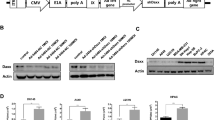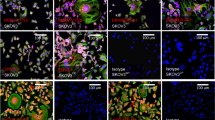Abstract
The expression of various proteins associated with rapid responses to inflammation and/or proliferation can be controlled at the level of mRNA stability. Because tumor cells continually recapitulate intracellular programs of proliferation, we have used tumor cell–selective stabilization of mRNA as a means to control therapeutic gene expression. We describe an adenoviral vector that is conditionally replication competent in which expression of the essential adenoviral early region 1A (E1A) gene is regulated by ligation to the 3′ untranslated region (UTR) of PTGS2 (also known as COX2), the gene encoding prostaglandin-endoperoxide synthase 2, allowing activated RAS/P-MAPK-specific stabilization of its mRNA. Induction of activated RAS supports replication, whereas matched cells in which activated RAS/P-MAPK is not expressed are very poor substrates for viral replication both in vitro and in vivo. Further tumor-targeting strategies will also be required to prevent viral replication at extratumoral sites where PTGS2 is normally induced. Many different genes contain 3′ UTRs that control selective mRNA stability under different physiological, pathological and tumor-associated conditions. Therefore, generating tumor selectivity at the level of mRNA stability is a strategy with broad potential applicability in vector design.
This is a preview of subscription content, access via your institution
Access options
Subscribe to this journal
Receive 12 print issues and online access
$209.00 per year
only $17.42 per issue
Buy this article
- Purchase on Springer Link
- Instant access to full article PDF
Prices may be subject to local taxes which are calculated during checkout





Similar content being viewed by others
References
Biederer, C., Ries, S., Brandts, C.H. & McCormick, F. Replication-selective viruses for cancer therapy. J. Mol. Med. 80, 163–175 (2002).
Verma, I. & Somia, N. Gene therapy–promises, problems and prospects. Nature 389, 239–242 (1997).
Vile, R.G., Russell, S.J. & Lemoine, N.R. Cancer gene therapy: hard lessons and new courses. Gene Ther. 7, 2–8 (2000).
Alemany, R., Balague, C. & Curiel, D.T. Replicative adenoviruses for cancer therapy. Nat. Biotechnol. 18, 723–727 (2000).
Kirn, D., Martuza, R.L. & Zwiebel, J. Replication-selective virotherapy for cancer: biological principles, risk management and future directions. Nat. Med. 7, 781–787 (2001).
Krasnykh, V., Belousova, N., Korokhov, N., Mikheeva, G. & Curiel, D.T. Genetic targeting of an adenovirus vector via replacement of the fiber protein with the phage T4 fibritin. J. Virol. 75, 4176–4183 (2001).
Rodriguez, R. et al. Prostate attenuated replication competent adenovirus (ARCA) CN706: a selective cytotoxic for prostate-specific antigen-positive prostate cancer cells. Cancer Res. 57, 2559–2563 (1997).
Bischoff, J. et al. An adenovirus mutant that replicates selectively in p53-deficient human tumor cells. Science 274, 373–376 (1996).
Ramachandra, M. et al. Reengineering adenovirus regulatory pathways to enhance oncolytic specificity and efficacy. Nat. Biotechnol. 19, 1035–1041 (2001).
Hallenbeck, P.L. et al. A novel tumor-specific replication-restricted adenoviral vector for gene therapy of hepatocellular carcinoma. Hum. Gene Ther. 10, 1721–1733 (1999).
Kurihara, T., Brough, D.E., Kovesdi, I. & Kufe, D.W. Selectivity of a replication-competent adenovirus for human breast carcinoma cells expressing the MUC1 antigen. J. Clin. Invest. 106, 763–771 (2000).
Siders, W.M., Halloran, P.J. & Fenton, R.G. Transcriptional targeting of recombinant adenoviruses to human and murine melanoma cells. Cancer Res. 56, 5638–5646 (1996).
Blackburn, R.V., Galoforo, S.S., Corry, P.M. & Lee, Y.J. Adenoviral-mediated transfer of a heat-inducible double suicide gene into prostate carcinoma cells. Cancer Res. 58, 1358–1362 (1998).
Ring, C.J.A., Harris, J.D., Hurst, H.C. & Lemoine, N.R. Suicide gene expression induced in tumour cells transduced with recombinant adenoviral, retroviral and plasmid vectors containing the ERBB2 promoter. Gene Ther. 3, 1094–1103 (1996).
Doyle, G.A., Bourdeau-Heller, J.M., Coulthard, S., Meisner, L.F. & Ross, J. Amplification in human breast cancer of a gene encoding a c-myc mRNA-binding protein. Cancer Res. 60, 2756–2759 (2000).
Bauer, S.R. et al. Altered myc gene transcription and intron-induced stabilization of myc RNAs in two mouse plasmacytomas. Oncogene 4, 615–623 (1989).
Ross, J. mRNA stability in mammalian cells. Microbiol. Rev. 59, 423–450 (1995).
Derrigo, M., Cestelli, A., Savettieri, G. & Di Liegro, I. RNA-protein interactions in the control of stability and localization of messenger RNA (review). Int. J. Mol. Med. 5, 111–123 (2000).
Chen, C.Y. & Shyu, A.B. AU-rich elements: characterization and importance in mRNA degradation. Trends Biochem. Sci. 20, 465–470 (1995).
Caput, D. et al. Identification of a common nucleotide sequence in the 3′-untranslated region of mRNA molecules specifying inflammatory mediators. Proc. Natl. Acad. Sci. USA 83, 1670–1674 (1986).
Shaw, G. & Kamen, R. A conserved AU sequence from the 3′ untranslated region of GM-CSF mRNA mediates selective mRNA degradation. Cell 46, 659–667 (1986).
Brook, M., Sully, G., Clark, A.R. & Saklatvala, J. Regulation of tumour necrosis factor alpha mRNA stability by the mitogen-activated protein kinase p38 signalling cascade. FEBS Lett. 483, 57–61 (2000).
Maity, A., McKenna, W.G. & Muschel, R.J. Evidence for post-transcriptional regulation of cyclin B1 mRNA in the cell cycle and following irradiation in HeLa cells. EMBO J. 14, 603–609 (1995).
Maity, A., McKenna, W.G. & Muschel, R.J. Cyclin A message stability varies with the cell cycle. Cell Growth Differ. 8, 311–318 (1997).
Lindsten, T., June, C.H., Ledbetter, J.A., Stella, G. & Thompson, C.B. Regulation of lymphokine messenger RNA stability by a surface-mediated T cell activation pathway. Science 244, 339–343 (1989).
Sheng, H., Shao, J. & Dubois, R.N. K-Ras-mediated increase in cyclooxygenase 2 mRNA stability involves activation of the protein kinase B1. Cancer Res. 61, 2670–2675 (2001).
Claffey, K.P. et al. Identification of a human VPF/VEGF 3′ untranslated region mediating hypoxia-induced mRNA stability. Mol. Biol. Cell 9, 469–481 (1998).
Chen, C.Y., Xu, N. & Shyu, A.B. mRNA decay mediated by two distinct AU-rich elements from c-fos and granulocyte-macrophage colony-stimulating factor transcripts: different deadenylation kinetics and uncoupling from translation. Mol. Cell Biol. 15, 5777–5788 (1995).
Ross, H.J., Sato, N., Ueyama, Y. & Koeffler, H.P. Cytokine messenger RNA stability is enhanced in tumor cells. Blood 77, 1787–1795 (1991).
Lee, C.H., Bradley, G. & Ling, V. Increased P-glycoprotein messenger RNA stability in rat liver tumors in vivo. J. Cell Physiol. 177, 1–12 (1998).
Sidransky, H., Murty, C.N. & Verney, E. Turnover of messenger RNA in transplantable hepatomas and host liver of rats. Cancer Res. 38, 1645–1653 (1978).
Cao, Y. & Prescott, S.M. Many actions of cyclooxygenase-2 in cellular dynamics and in cancer. J. Cell Physiol. 190, 279–286 (2002).
Bakhle, Y.S. COX-2 and cancer: a new approach to an old problem. Br. J. Pharmacol. 134, 1137–1150 (2001).
Turini, M.E. & DuBois, R.N. Cyclooxygenase-2: a therapeutic target. Annu. Rev. Med. 53, 35–57 (2002).
Sheng, H. et al. Cyclooxygenase-2 induction and transforming growth factor β growth inhibition in rat intestinal epithelial cells. Cell Growth Differ. 8, 463–470 (1997).
Sheng, G.G. et al. A selective cyclooxygenase 2 inhibitor suppresses the growth of H-ras-transformed rat intestinal epithelial cells. Gastroenterology 113, 1883–1891 (1997).
Sheng, H. et al. Induction of cyclooxygenase-2 by activated Ha-ras oncogene in Rat-1 fibroblasts and the role of mitogen-activated protein kinase pathway. J. Biol. Chem. 273, 22120–22127 (1998).
Heasley, L.E. et al. Induction of cytosolic phospholipase A2 by oncogenic Ras in human non-small cell lung cancer. J. Biol. Chem. 272, 14501–14504 (1997).
Sheng, H. et al. Transforming growth factor-β1 enhances Ha-ras-induced expression of cyclooxygenase-2 in intestinal epithelial cells via stabilization of mRNA. J. Biol. Chem. 275, 6628–6635 (2000).
Dixon, D.A., Kaplan, C.D., McIntyre, T.M., Zimmerman, G.A. & Prescott, S.M. Post-transcriptional control of cyclooxygenase-2 gene expression. The role of the 3′-untranslated region. J. Biol. Chem. 275, 11750–11757 (2000).
Montero, L. & Nagamine, Y. Regulation by p38 mitogen-activated protein kinase of adenylate- and uridylate-rich element-mediated urokinase-type plasminogen activator (uPA) messenger RNA stability and uPA-dependent in vitro cell invasion. Cancer Res. 59, 5286–5293 (1999).
Gallouzi, I.E. et al. A novel phosphorylation-dependent RNase activity of GAP-SH3 binding protein: a potential link between signal transduction and RNA stability. Mol. Cell Biol. 18, 3956–3965 (1998).
Chong, H., Ruchatz, A., Clackson, T., Rivera, V.M. & Vile, R.G. A system for small-molecule control of conditionally replication-competent adenoviral vectors. Mol. Ther. 5, 195–203 (2002).
Maity, A. & Solomon, D. Both increased stability and transcription contribute to the induction of the urokinase plasminogen activator receptor (uPAR) message by hypoxia. Exp. Cell Res. 255, 250–257 (2000).
Henderson, B.R., Tansey, W.P., Phillips, S.M., Ramshaw, I.A. & Kefford, R.F. Transcriptional and posttranscriptional activation of urokinase plasminogen activator gene expression in metastatic tumor cells. Cancer Res. 52, 2489–2496 (1992).
Li, Y.C. & Lieberman, M.W. Two genes associated with liver cancer are regulated by different mechanisms in rasT24 transformed liver epithelial cells. Oncogene 4, 795–798 (1989).
Stauber, C. & Schumperli, D. 3′ processing of pre-mRNA plays a major role in proliferation-dependent regulation of histone gene expression. Nucleic Acids Res. 16, 9399–9414 (1988).
Yamamoto, M., Alemany, R., Adachi, Y., Grizzle, W.E. & Curiel, D.T. Characterization of the cyclooxygenase-2 promoter in an adenoviral vector and its application for the mitigation of toxicity in suicide gene therapy of gastrointestinal cancers. Mol. Ther. 3, 385–394 (2001).
Acknowledgements
The work in this manuscript is dedicated to the memory of Ashfaq Uddin Ahmed. We thank Toni Higgins for expert secretarial assistance. A.A., J.T. and R.V. are supported by the Mayo Foundation.
Author information
Authors and Affiliations
Corresponding author
Ethics declarations
Competing interests
The authors declare no competing financial interests.
Rights and permissions
About this article
Cite this article
Ahmed, A., Thompson, J., Emiliusen, L. et al. A conditionally replicating adenovirus targeted to tumor cells through activated RAS/P-MAPK-selective mRNA stabilization. Nat Biotechnol 21, 771–777 (2003). https://doi.org/10.1038/nbt835
Received:
Accepted:
Published:
Issue Date:
DOI: https://doi.org/10.1038/nbt835
This article is cited by
-
Current Issues and Future Directions of Oncolytic Adenoviruses
Molecular Therapy (2010)
-
MicroRNAs and the Regulation of Vector Tropism
Molecular Therapy (2009)
-
Cancer-specific targeting of a conditionally replicative adenovirus using mRNA translational control
Breast Cancer Research and Treatment (2008)
-
Cellular genetic tools to control oncolytic adenoviruses for virotherapy of cancer
Journal of Molecular Medicine (2008)
-
Intratumoral expression of a fusogenic membrane glycoprotein enhances the efficacy of replicating adenovirus therapy
Gene Therapy (2003)



